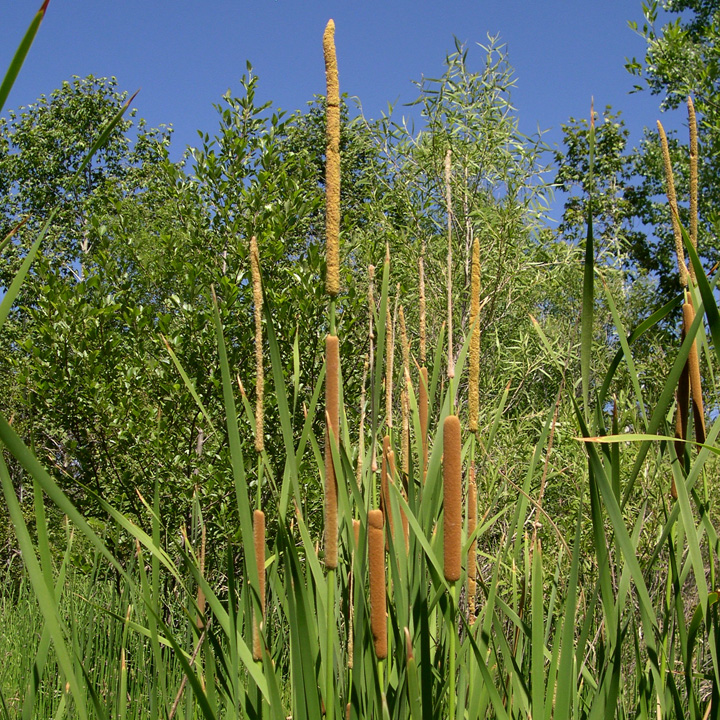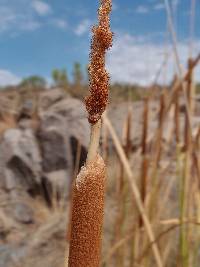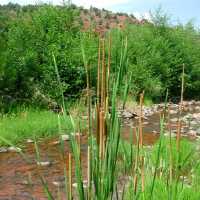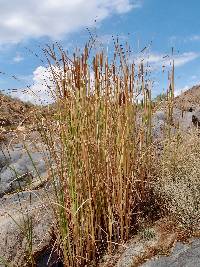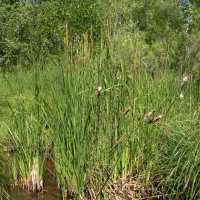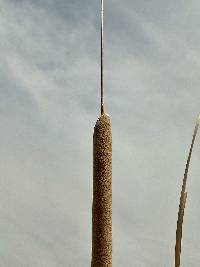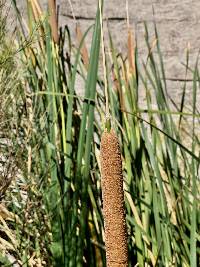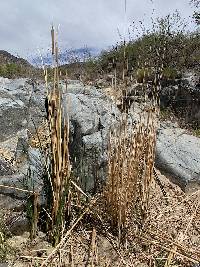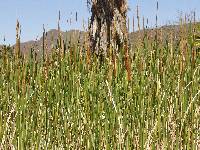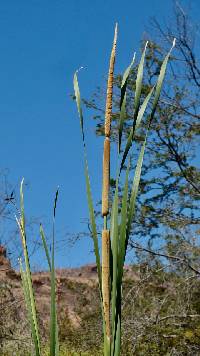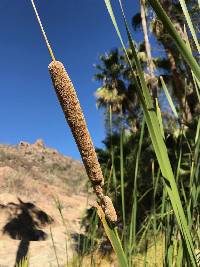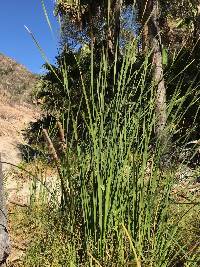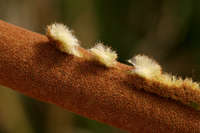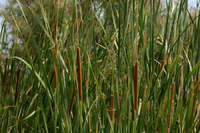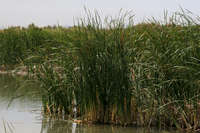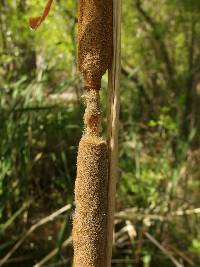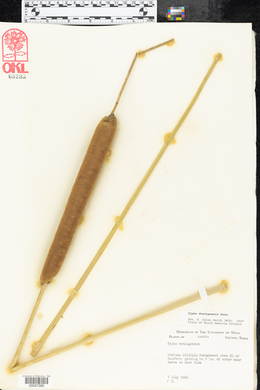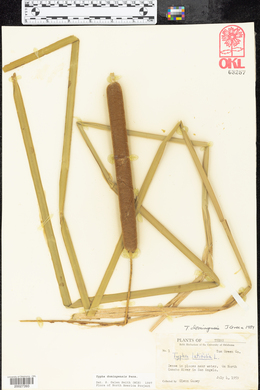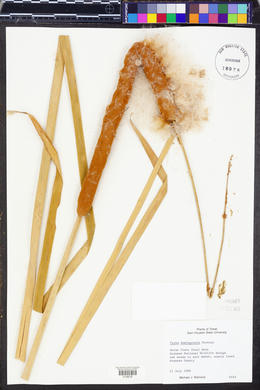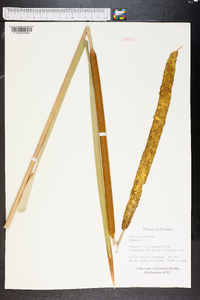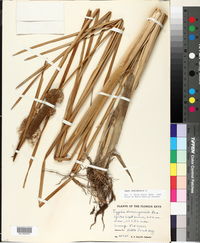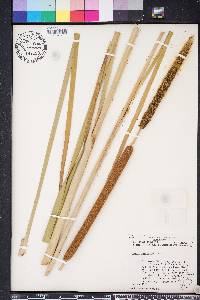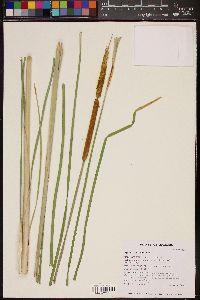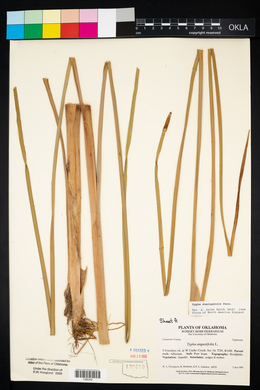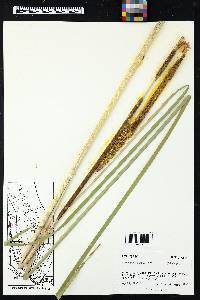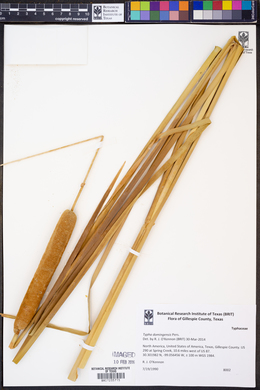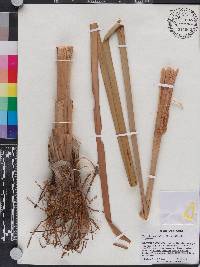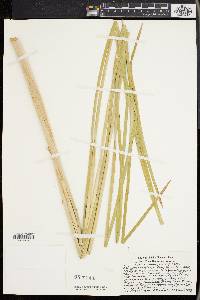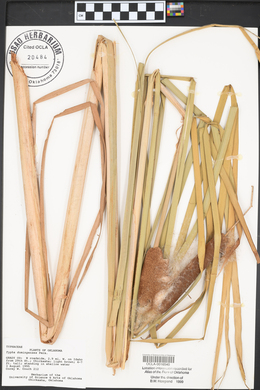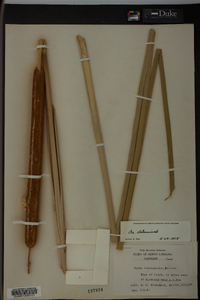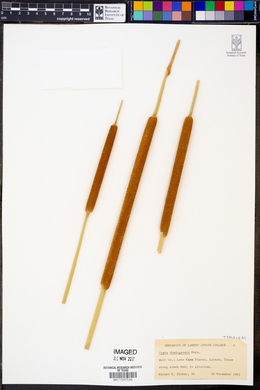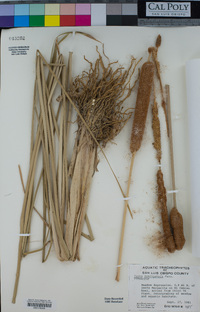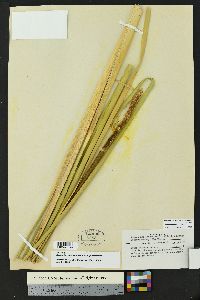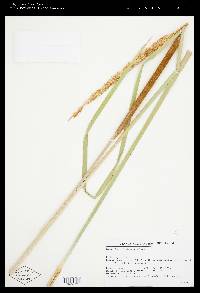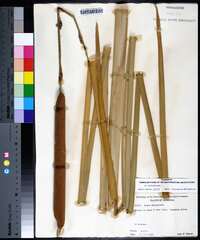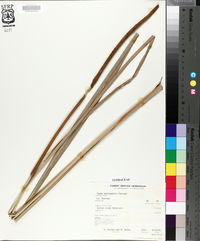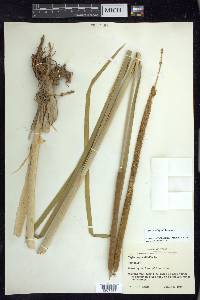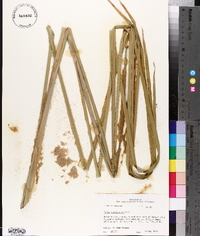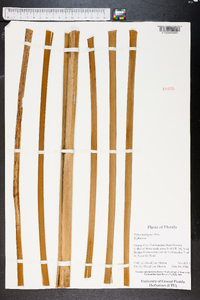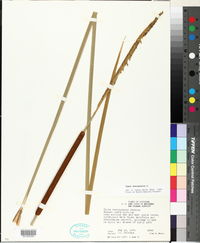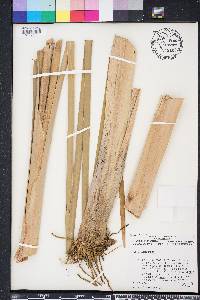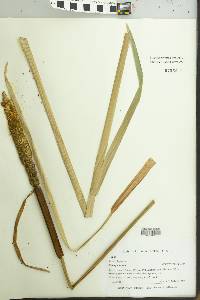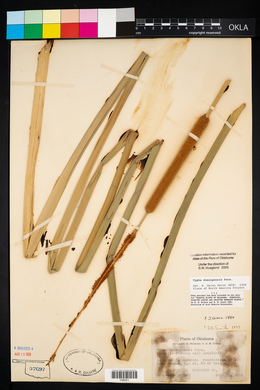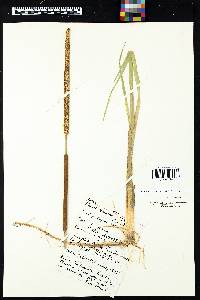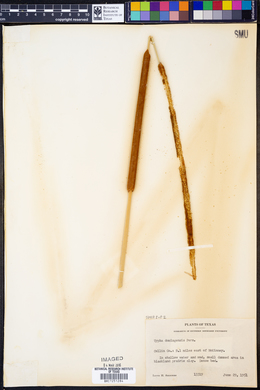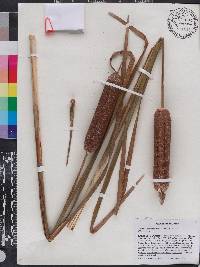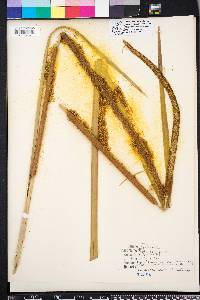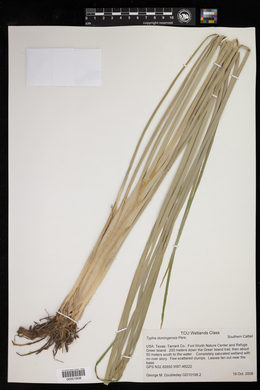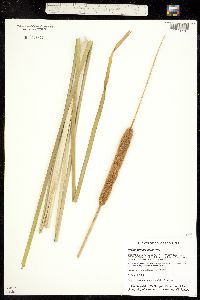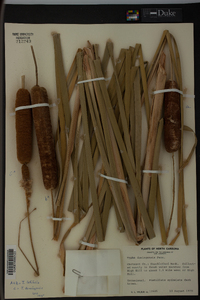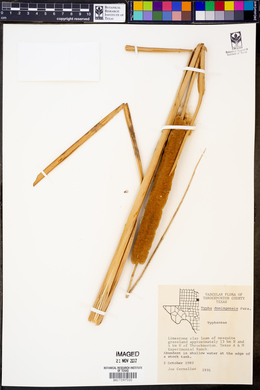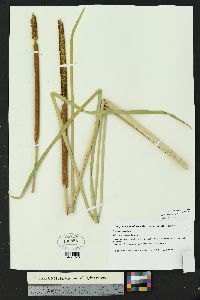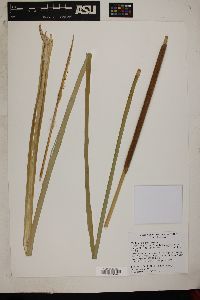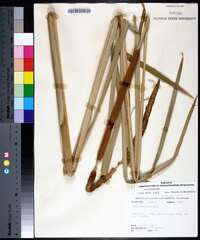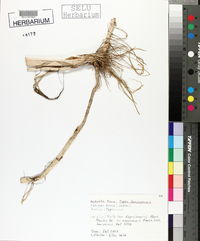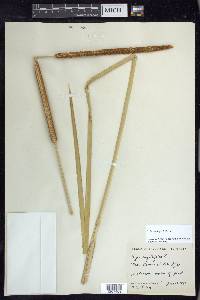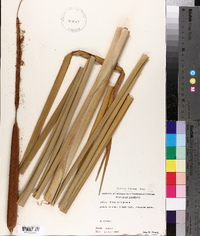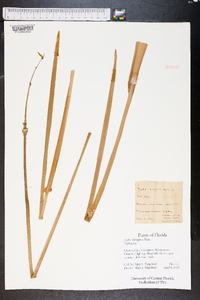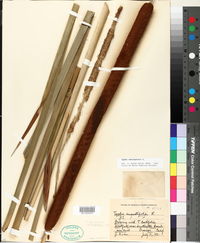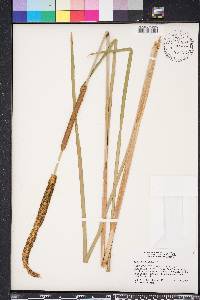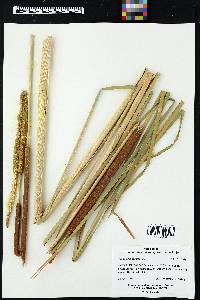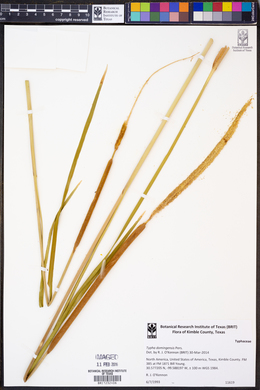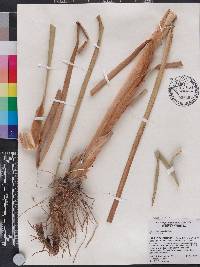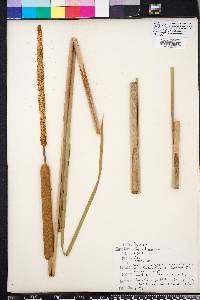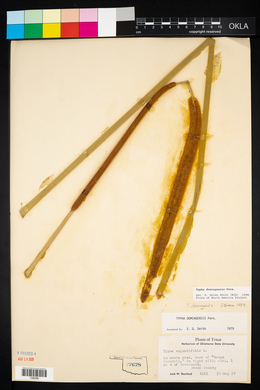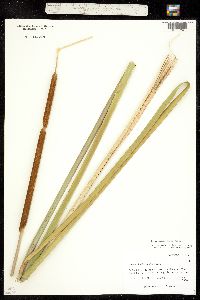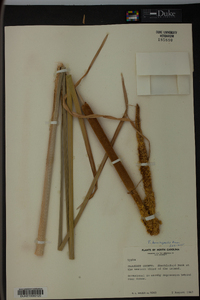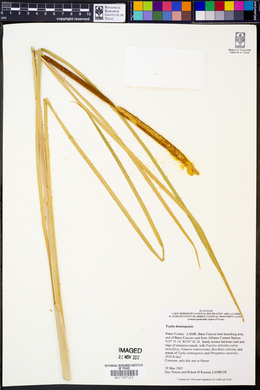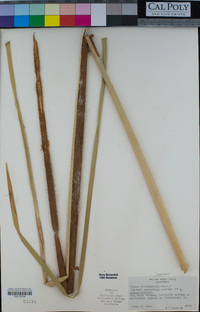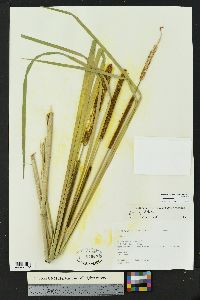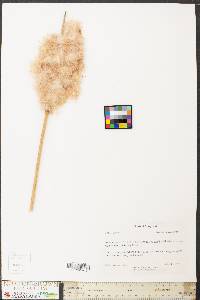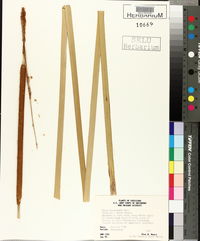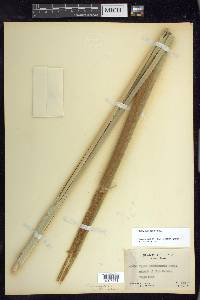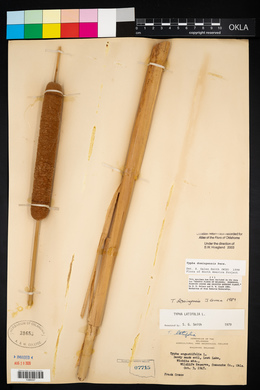Typha domingensis
|
|
|
|
Family: Typhaceae
Southern Cat-Tail, more...southern cattail, Cattail (es: tule)
[Typha aequalis Schnizl., moreTypha aethiopica (Rohrb.) Kronfeldt, Typha angustata Bory & Chaubard, Typha angustata var. abyssinica Graebn., Typha angustata var. aethiopica Rohrb., Typha angustifolia subsp. javanica (Schnizl. ex Rohrb.) Graebn., Typha australis Schumach., Typha domingensis subsp. australis (Schumach.) F.M. Vázquez, Typha javanica Schnizl. ex Rohrb., Typha schimperi Rohrb., Typha tenuifolia Kunth, Typha truxillensis Kunth] |
Erect shoots 150--400 cm, not glaucous; flowering shoots 1--2 cm thick in middle; stems 3--4 mm thick near spike. Leaves: sheath sides membranous, margin broadly clear, summit tapered to blade or with persistent, membranous auricles; mucilage glands at sheath-blade transition orange-brown, numerous on entire sheath and proximal 1--10 cm of blade; widest blades on shoot 6--18 mm wide when fresh, 5--15 mm when dry; distal blade about equaling inflorescence. Inflorescences: staminate spike separated from pistillate by (0--)1--8 cm of naked axis, ca. 1.4 X longer than pistillate, 1 cm thick at anthesis; staminate scales straw-colored to mostly bright orange-brown, variable in same spike, linear to cuneate, often laciniate distally, to 3--4 0.3 mm; pistillate spikes in flower when fresh bright cinnamon-brown with whitish stigmas (drying brownish), later orange- (to medium) brown, in fruit generally paler as stigmas and often bracteole blades wear off, ca. 6--35 cm 5--6 mm in flower, 15--25 mm in fruit; compound pedicels in fruit peg-like, ca. 0.6--0.9 mm; pistillate bracteole blades forming spike surface before flowering, later slightly exceeded by stigmas and slightly exceeding pistil hairs, straw-colored to bright orange-brown, much paler than to nearly same color as stigmas, irregularly narrowly to broadly spatulate or lanceolate, 0.8 0.1--0.3 mm, mostly wider than stigmas, apex variable in same inflorescence or different plants, acute or acuminate. Staminate flowers 5 mm; anthers 2--2.5 mm, thecae yellow, apex bright orange-brown; pollen in single grains. Pistillate flowers 2 mm in flower, 8--9 mm in fruit; pistil-hair tips straw-colored to orange-brown in mass, usually with 1 subapical bright orange-brown, generally enlarged cell; stigmas often deciduous in fruit, in flower erect, elongating, bending to form surface mat, white in flower when fresh, later bright orange-brown, narrowly linear-lanceolate, ca. 1 0.1 mm; carpodia slightly exceeded by pistil hairs, usually evident at fruiting spike surface, straw-colored, orange-spotted, apex broadly rounded. 2n = 30. Flowering spring--summer. Often in brackish water or wet soil; 0--2000 m; Ala., Ariz., Ark., Calif., Colo., Del., Fla., Ga., Ill., Kans., Ky., La., Md., Miss., Mo., Nebr., Nev., N.Mex., N.C., Okla., S.C., Tex., Utah, Va., Wyo.; Mexico; West Indies; Central America; South America; West Indies; Eurasia; Africa; Pacific Islands (New Zealand); Australia. Typha domingensis aggressively invades and forms nearly pure stands in brackish or nutrient-enriched wetlands in the Florida Everglades and elsewhere. It is established but does not mature fruits on the cold coast of northern California. There are specimens of putative hybrids with T. angustifolia beyond the main range of T. domingensis, in southeastern and northwestern Nebraska and southeastern Kentucky, and with T. latifolia in southeastern Nebraska. Vegetative T. domingensis or hybrids occur on the Atlantic Coast north as far as Delaware. (S. G. Smith, unpublished). The northern Illinois locality is a power plant cooling pond. The Wyoming record is from a hot spring and may be a hybrid with T. latifolia. Typha domingensis probably should be treated as a highly variable pantropic and warm temperate species, occurring to 40º E north and south latitude worldwide, and needing study to determine infraspecific taxa and delimitation from related species (B. G. Briggs and L. A. S. Johnson and B. G. Briggs 1968; S. G. Smith 1987). For hybrids see also genus and key. Other References (plus corrections and additions) missing from this file. Have added and corrected these data with Bob´s 2d blue-line.
Plant: Tall perennial graminoid Leaves: 6-9(-12), light yellowish green, 6-12(-15) mm wide, flat but moderately convex on the back, the sheath cylindrical and open at the throat, with scarious margins tapering to the blade INFLORESCENCE: (including stems) 2.5-4 m tall, about as long as the leaves, with the pistillate and staminate portions separated by 1-4 cm; staminate spikes 20-40 cm long, the pistillate spikes light brown, 15-25 cm long, 1.5-2.5 cm thick Flowers: STAMINATE FLOWERS: pollen golden-yellow, in monads. PISTILLATE FLOWERS light brown, with obovate to oblanceolate, translucent to light brown bracts exceeding the stipe hairs, arranged on stout "compound pedicels" 0.5-0.8 mm long, these with numerous hair-like appendages, the stigma light brown, linear; surface of the main stem axis minutely bristly Fruit: ellipsoid, 0.8-1 mm long, long stalked, minute nutlets, dry, tardily dehiscent, buoyant; SEEDS albuminous, striate, with mealy endosperm Misc: In brackish or fresh marshes, streams, rivers, ponds and lakes; 300-1800 m (1000-6000 ft); Mar-Nov (fr. Jun-Jan) References: J.C. Hickman, ed. The Jepson Manual.ASU specimens. Ricketson, Jon. 2001. Sparganiaceae. J. Ariz. - Nev. Acad. Sci. Volume 33(1). Perennial colony-forming herb 1.5 - 4 m tall Stem: erect, unbranched, 3 - 4 mm thick near the inflorescence. Leaves: sheathed at the base, long and narrow with the uppermost blade about equalling the inflorescence, 6 - 18 mm wide when fresh and 5 - 15 mm wide when dry, loosely twisted. The intersection of the sheath and blade is membranous and sometimes has persistent ear-shaped appendages (auricles). Inflorescence: a dense cylindric terminal spike with the male part separated above the female part by 1 - 8 cm (rarely touching). The male part is about 1.4 times longer than the female part, about 1 cm thick, with straw-colored to mostly bright orangish brown scales that are 3 - 4 mm long, to 0.3 mm wide, linear to wedge-shaped and often deeply cut into slender segments near the tip. Female part bright cinnamon-brown with whitish stigmas drying brown, becoming paler in fruit, 6 - 35 cm long, 5 - 6 mm wide, becoming 1.3 - 2.5 cm wide in fruit. Fruit: a tiny dry follicle borne on a slender stalk, the stalk having many long white hairs usually with a large brown cell near the tip, each follicle single-seeded. Male flowers: 5 mm long, with 2 - 2.5 mm long anthers that are yellow with a bright orangish brown tip and solitary pollen. Female flowers: subtended by spoon- to lance-shaped bracts with a pointed tip, 2 mm long. Straw-colored to orangish brown pistil-hair tips often have an enlarged bright orangish brown cell near the tip, and the lance-linear stigmas are white but dry to bright orangish brown before falling in fruit. Similar species: Typha angustifolia has dark brown fruiting spikes and rounded female flower bract tips. Typha latifolia has inflorescences with the male and female parts usually touching each other, pollen grains in clusters of four, and female flowers with spoon- to egg-shaped stigmas but without bracts. Flowering: June to October Habitat and ecology: Native to the southern United States. The only Chicago Region population of this species grows at a power plant cooling pond in Will County. Occurence in the Chicago region: non-native Etymology: Typha comes from the word typhe, the old Greek name for cat-tail. Domingensis means "of Santo Domingo." Author: The Morton Arboretum Ricketson 2001, FNA 2000 Common Name: southern cattail Duration: Perennial Nativity: Native Lifeform: Forb/Herb General: Perennial herbaceous graminoid, 2.5-4 m tall, from extensive creeping rhizomes; stems erect, cylindric and pithy. Vegetative: Leaves alternate along the stems, with sheathing bases; 6-9 leaves per stem; sheaths cylindric and open at throat, with scarious margins that taper to the blade; blades thick and spongy, light yellowish green, 6-12 mm wide and about as long as the stems, flat but moderately convex on the back. Inflorescence: Male spike, 20-40 cm long, is located at the top of the stem, and the female spike, 15-25 cm long and 15-25 mm diameter, is located just below the male spike on the same stem; 1-4 cm of bare stem separates these two spikes; spikes are cylindrical, with hundreds of tiny flowers packed together; flowers lack petals and sepals; male flowers release copious golden pollen when touched, and are ephemeral (falling off the stem soon after pollen is distributed); female spikes are light brown; when mature, tiny seeds and accompanying long filiform hairs are released from female spikes in large clumps. Ecology: Found in brackish to fresh marshes and streams, rivers, lakes and ponds from 1,000-6,000 ft (305-1829 m); flowers March-November. Distribution: Throughout the southern half of the US, from MD to FL, west to CA Notes: This is the commmon cattail of the US Southwest, especially at the lower and middle elevations; it can be distinguished from T. latifolia based on the 1-4 cm gap of bare stem between the male and female spikes; and the narrow, light yellowish green leaves, 6-12 mm wide, which are moderately convex on the back (feel a leaf blade with your hand-- it feels as if the cross section has a slight crescent-moon shape). T. latifolia, the common cattail of the Rocky Mountains and found in the Southwest at higher elevations, does not have a gap of bare stem between the male and female spikes; and the leaves are light green, wider on average (6-23 mm wide), and flat on the back. Ethnobotany: Young stalks, roots, and seeds were eaten as food, the latter winnowed and toasted and made into meal; used for thatch in houses, weirs, sandals, and clothing; the fluffy absorbant seeds were used in early versions of baby diapers and menstrual pads. Etymology: Typha is derived from the Greek word typhe, marsh or fen, alluding to the plant's habitat; domingensis means of or from Santo Domingo. Synonyms: Typha angustata Editor: SBuckley 2010, AHazelton 2017 Much like no. 2 [Typha angustifolia L.], but taller (often 2.5-4 m) and with more numerous lvs, these thicker, up to 15 mm wide, often some or all of them exauriculate; pistillate portion of the spike light brown, 1.3-2.5 cm thick at maturity, separated from the staminate portion by up to 8 cm, rarely contiguous with it; pistillate bracteoles acuminate; sterile pistillate fls narrowly cuneate at the tip; hairs subtending the fr white with usually a single large brown cell near the tip; pollen in monads; 2n=30. Pantrop., extending n. in coastal marshes to Md. and Del., and n. inland to Nebr. and Utah. Gleason, Henry A. & Cronquist, Arthur J. 1991. Manual of vascular plants of northeastern United States and adjacent Canada. lxxv + 910 pp. ©The New York Botanical Garden. All rights reserved. Used by permission. |
|
|
|

